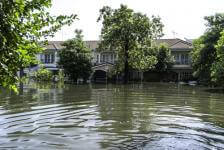4 Major Disasters Homeowners and Renters Insurance Won’t Cover
Money Girl explains 4 major disasters that are surprisingly not covered by home or renters insurance.

Unfortunately, many people don’t realize this until after a disaster strikes and it’s too late. So, in this episode, I’ll review what is and isn’t covered by home or renters insurance. You’ll learn 4 major disasters that are surprisingly not covered, and what to do to stay safe.
What Homeowners Insurance Covers
Last week, after the strongest earthquake in 25 years hit northern California, I was chatting with a Money Girl Facebook follower named Mariela. She said, “I’m so glad I got earthquake insurance because of you!” She gets a virtual high-five.
Sadly, many people without earthquake insurance won’t be feeling so grateful when they attempt to make a claim and find out that their damage isn’t covered by a typical homeowners or renters policy.
Before I tell you more about what is not covered by a home policy, let’s back up so you understand what is. A standard homeowners policy gives you 4 main types of coverage:
- Dwelling coverage: pays to rebuild or repair damage to the structure of your home caused by a covered event, such as a fire, hurricane, hail, lightning, vandalism, or other disaster listed in your policy.
- Contents coverage: pays to repair or replace your damaged or stolen personal belongings, such as furniture, sporting equipment, and clothes. You’re covered anywhere in the world, as long as the loss is caused by a covered event.
- Liability coverage: protects you if you’re sued because you, family members, or pets cause property damage or medical injury on your property, or while you’re away from home.
- Additional living expenses: pays you a certain amount if you’re temporarily unable to live in your home due to a covered event, such as a fire, lightning strike, or storm.
See also: 5 Ways to Save Money on Home Insurance
What Renters Insurance Covers
If you rent an apartment, condo, or house, you need renters insurance. It gives you many of the same protections as homeowners insurance, except that you don’t insure the physical dwelling—that’s the landlord’s responsibility.
A standard renters policy protects you against the same covered disasters as home insurance, such as fire, lightning, storms, and theft. It covers your personal belongings, liability, and additional living expenses, if you have to move out while repairs are being made.
Renters insurance is a very inexpensive policy that costs $185 a year on average across the U.S. Remember that in the event of a disaster, your landlord might be sympathetic about your damaged or stolen possessions, but he or she isn’t obligated to replace them for you.
Read or listen to Your Guide to Renters Insurance, to learn more.
See also: Do College Students Need Renters Insurance?
4 Major Disasters Homeowners and Renters Insurance Won’t Cover
Now that you know what home and renters insurance generally covers, here are 4 major disasters that they won’t cover:
Disaster #1: Earthquakes
Basic home and renters policies don’t cover earthquake damage to your property or personal belongings. As you can imagine, intense shaking can destroy entire buildings and valuable contents.
Note that if fire erupts or broken pipes cause water damage following an earthquake, those damages would be covered by a typical home policy in most states.
While a flood may seem very different from an earthquake, they do have something in common: neither one is covered on a standard home or renters insurance policy.
A majority of the world’s strongest earthquakes take place on the Pacific Coast, from Southern California to Alaska. But the U.S. Geological Survey says that more than 20 states have experienced measurable earthquake activity in the past 30 years. I’ve lived in South Carolina and Florida, and felt earthquakes in both of those states.
You can see a map of the top earthquake states at the U.S. Geologic Survey website, earthquake.usgs.gov.
In most states, home insurers offer earthquake insurance as a supplement, and premiums vary widely depending on the risk factors where you live. Contact your insurance agent or company to get an earthquake quote. If you live in California, check out the California Earthquake Authority (CEA) premium calculator to see rates for your area.
Disaster #2: Floods
While a flood may seem very different from an earthquake, they do have something in common: neither one is covered by a standard home or renters insurance policy.
Don’t think that just because you don’t live on a river or ocean,you’ll never experience a flood. According to the federal government’s National Flood Insurance Program, nearly 20% of flood claims come from low- to moderate-risk areas.
Flood insurance is issued by the federal government and a few private insurers, but is sold through independent agents or insurance representatives. If you have a mortgage, flood insurance may be required by your lender if you live in a high-risk flood area.
Just like with earthquake coverage, premiums for flood insurance vary depending on where you live, but may be as low as $129 per year. Visit floodsmart.gov to learn more.
Disaster #3: Sewer backups
Would it be poor taste to say that having a sewer backup really stinks? Not just because it’s a health hazard, but because cleaning it up typically isn’t covered by a standard home insurance policy.
Homeowners are responsible for maintenance of their sewer lines. If you have a sewer backup due to aging pipes, blockages from tree roots, or from excess storm water runoff, it can ruin floors, walls, electrical systems, and personal belongings.
The good news is that you can get an endorsement to your homeowners policy to cover sewer backups that could cost as little as $50 per year.
Disaster #4: Mold
Mold is another health hazard that can creep up on you in your home. According to the Insurance Information Institute, there are over 1,000 different species of mold in the U.S. It can make you sick, cause allergic reactions, and be expensive to clean up.
But a standard homeowners policy typically limits coverage for mold damage, or excludes it. Some insurers offer an endorsement to increase your protection against mold.
How to Protect Your Property from Natural Disasters
The best way to protect your property and belongings from the risk of various natural disasters is to discuss your potential risk with an insurance company or agent. Ask whether you need specialized coverage beyond what a typical home or renters policy provides.
Get multiple quotes and advice from different insurance providers, such as:
Then weigh the information you’re given carefully. Ask about what discounts you may qualify for, such as having an alarm system, smoke detectors, or a new roof. Also, remember that maintaining good credit helps reduce the cost of insurance. Read or listen to What You Should Know About Credit-Based Insurance Scores to learn more.
Take the time to review all your insurance at least once a year to make sure you aren’t over- or under-insured and have the most affordable coverage possible.
Wondering which financial tools Money Girl uses to earn more, save more, and accomplish more with her money? Click here for over 25 of the best finance tools!
 Get More Money Girl!
Get More Money Girl!
For exclusive money tips not covered on the Money Girl podcast, click here and sign up for the free Money Girl Newsletter! To connect on social media, you’ll find Money Girl on Facebook, Twitter, Pinterest, and Google+. Or email me at money@quickanddirtytips.comcreate new email“>money@quickanddirtytips.comcreate new email
Also, if you’re not already subscribed to the Money Girl podcast on iTunes, that’s how most people get the show. Subscribing is always free and makes sure that you’ll get each new weekly episode as soon as it’s published on the web.There’s a huge archive of past articles and podcasts if you type in what you want to learn about in the search bar at the top of the page.
Download FREE chapters of Money Girl’s Smart Moves to Grow Rich
To learn about how to get out of debt, save money, and build wealth, get a copy of my book Money Girl’s Smart Moves to Grow Rich. It tells you what you need to know about money without bogging you down with what you don’t. It’s available at your favorite book store in print or as an e-book for your Kindle, Nook, iPad, PC, Mac, or smart phone. You can even download 2 free book chapters at SmartMovesToGrowRich.com
Heavy Flooding image courtesy of Shutterstock
You May Also Like…




 Get More Money Girl!
Get More Money Girl!

